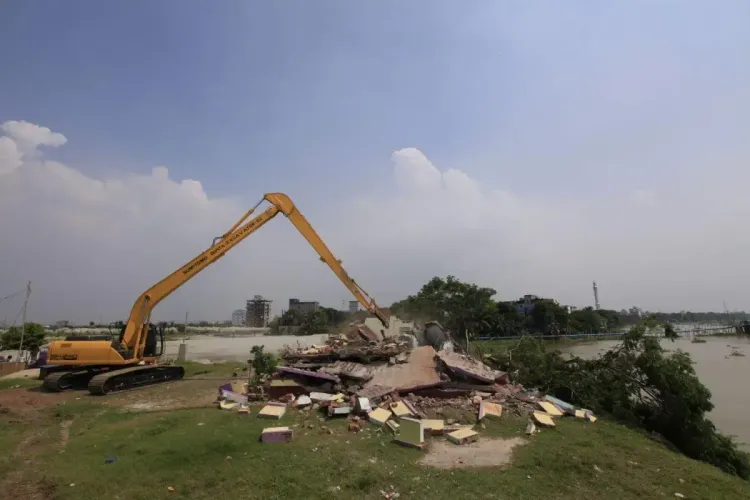Are Millions of Bangladeshis Facing Threats from Water-Driven Changes?

Synopsis
Key Takeaways
- Over 22 million Bangladeshis face risks from hydrogeomorphic hazards.
- 86 percent of those affected are from impoverished households.
- These hazards can lead to permanent land loss and displacement.
- Long-term impacts include threats to food security and livelihoods.
- Urgent action is needed to address these challenges.
London, Nov 26 (NationPress) More than 22 million individuals — which accounts for roughly 13 percent of Bangladesh's populace — reside in regions undergoing rapid, water-induced landscape transformations, such as riverbank erosion, land degradation, and fluctuating river paths. This information stems from the inaugural examination of hydrogeomorphic hazards, as outlined in a report released on Wednesday.
Remarkably, 86 percent of those at risk belong to the most impoverished households, highlighting profound inequalities at the convergence of climate vulnerabilities, poverty, and developmental challenges in the South Asian country.
“The study, published in Nature Communications, demonstrates that these hydrogeomorphic dangers — which differ from floods or storms — can irrevocably alter land, obliterate residences and agricultural areas, and repeatedly displace at-risk communities. By 2050, exposure to these threats is anticipated to escalate due to increasing population pressures,” according to a report from the Environmental Change Institute (ECI), part of the University of Oxford’s School of Geography and the Environment.
The research, spearheaded by Amelie Paszkowski, a Research Associate at ECI and a member of the Oxford Programme for Sustainable Infrastructure Systems (OPSIS), is the first to assess Bangladesh’s vulnerability to hydrogeomorphic hazards.
“Utilizing 35 years of satellite imagery and advanced hydrogeomorphic modeling, the research team identified areas in Bangladesh where the land surface has undergone significant changes—and mapped the demographics of those residing in these precarious zones. They discovered that the poorest households are twice as likely as wealthier families to live in areas threatened by these prolonged landscape alterations,” the report indicated.
“Unlike floods, which often allow people to return once waters recede, hydrogeomorphic changes can permanently obliterate land, leaving families without homes, farmland, or feasible relocation options. This chronic, often overlooked hazard has lasting repercussions on food security, livelihoods, education, and debt,” it further noted.
Paszkowski emphasized the necessity of incorporating these hazards into Bangladesh’s climate adaptation and development frameworks.
“Individuals are not merely recovering from water—they are losing the ground beneath them,” she stated.
Highlighting the wider implications, co-author Professor Jim Hall, who leads OPSIS, remarked, “This research unveils risk patterns that have been obscured. The dangers posed by geomorphic changes are not widely recognized, yet in the rapidly changing rivers that traverse densely populated deltas, the consequences for people, especially the most vulnerable, can be profoundly detrimental. Hydrogeomorphic hazards must be integrated into disaster risk management and poverty alleviation plans.”
With projections indicating a potential 29 percent rise in exposure by 2050 in Bangladesh, the authors advocate for enhanced social protection for communities in at-risk areas and infrastructure designed to adapt to enduring landscape changes. They also stressed the importance of planning strategies that highlight regions vulnerable to permanent land loss, along with targeted measures for the impoverished, who face the highest risks.









